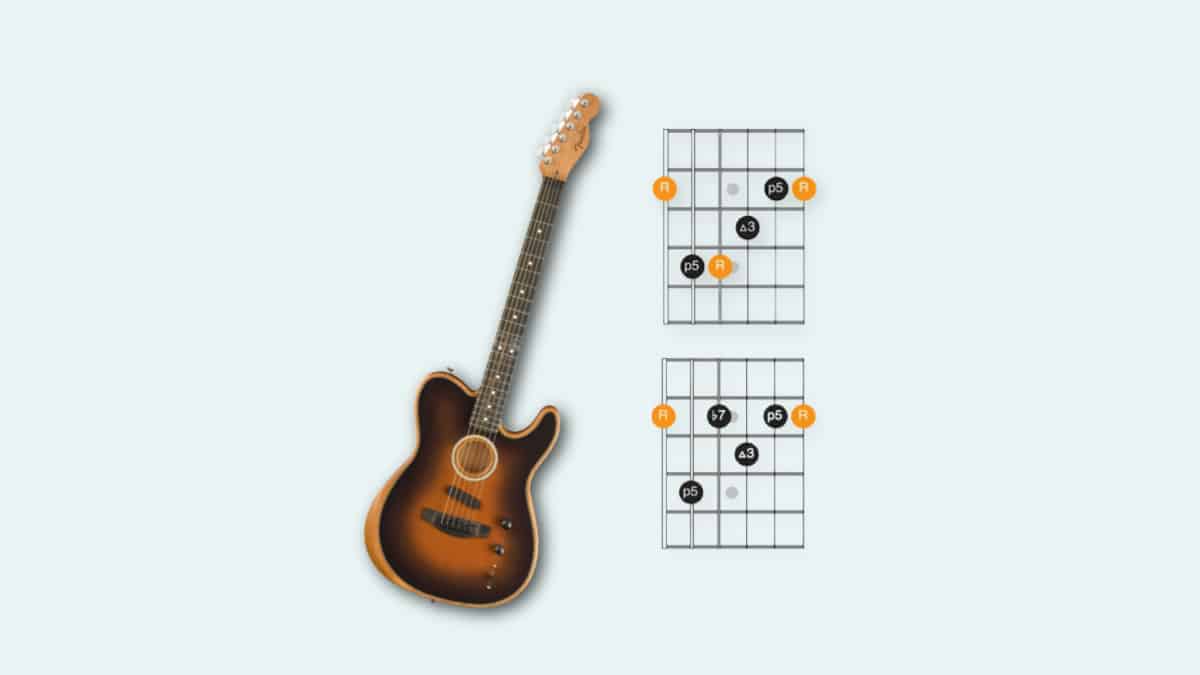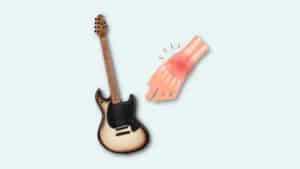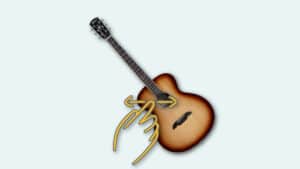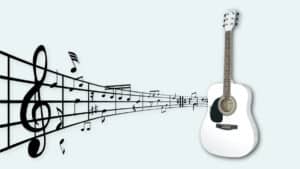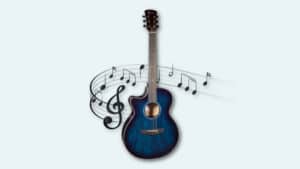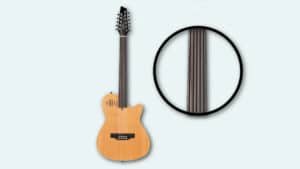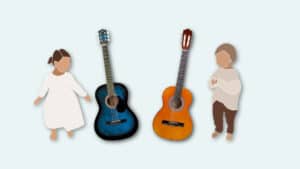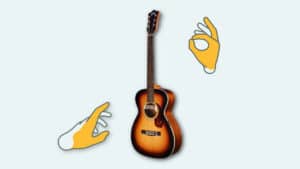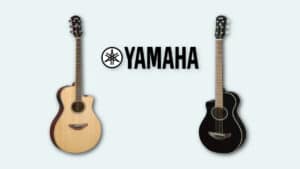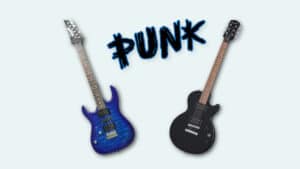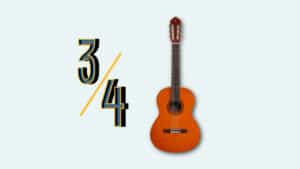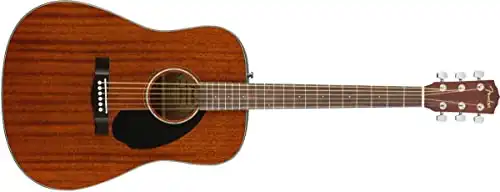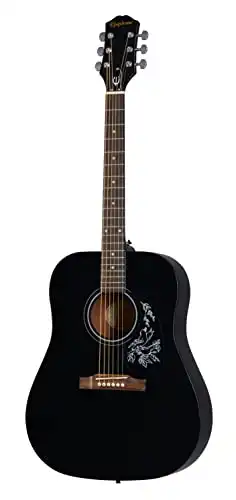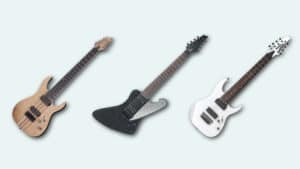Is it difficult to learn how to play the guitar?
Yes, in the beginning the guitar can be quite challenging to learn. However, once you’re familiar with some basic chords and strumming techniques, learning the rest of the fretboard won’t be too difficult.
Typically it takes about 1-2 months with 30 minutes of practice five days a week to learn how to play beginner songs.
How challenging can learning guitar be? Well, learning anything new can be daunting, but it gets crazy when that something has six different strings.
There are so many factors to consider, from finding the right teacher to having enough time to practice. And then there’s the matter of learning the actual skills required to play guitar.
If you’re looking at learning guitar from a beginner’s perspective, then it’s understandable that you might feel overwhelmed.
But don’t worry. I’ll help you navigate the challenges and get you on your way to becoming a guitar pro in no time.
Why is the Guitar Hard to Learn?
The guitar is a challenging instrument to learn for numerous reasons. A big one is that you’re asking your hands and fingers to move in ways that don’t come naturally. While this gets easier with time and repetition, developing these motor skills can be difficult and uncomfortable.
According to a study conducted by Fender, 90% percent of learners quit within the first three months. Below are some of the reasons why most of us find it hard to learn guitar.
1. Playing the Guitar is a Big Time Commitment
In order to get good at it, you’ll need to be willing to put in the time and effort required to practice regularly.
This can be tough for people who have busy schedules or other obligations that take up their time. If you’re not able to commit to a regular practice routine, then learning guitar will likely be more difficult for you.
In addition, some people find the physical aspects of playing guitar to be challenging. For instance, holding down chords with the left hand while strumming with the right can be tricky for beginners.
The more frequently you practice your guitar skills, the better you will become. So, if you’re able to commit to a regular practice schedule, learning guitar will be much easier for you.
If you start practicing for at least 30 minutes a day for five days a week, you’ll be able to learn the basic version of all your favorite songs within a year. Keep it up, and by the end of the year you’ll be jamming to some Led Zepplin and Red Hot Chili Peppers with a bit of ease.
2. Playing the Guitar Can be Tough on Your Body
In order to play guitar, you’ll need to use your hands and fingers in a variety of ways. This can be tough on your muscles and joints, especially if you’re not used to it.
If you’re experiencing pain or discomfort while trying to learn guitar, take a break and give your body some time to rest. Once you’re feeling better, you can start practicing again.
Some people find the mental aspects of playing guitar to be challenging. For instance, memorizing chords and melodies can be difficult for some people.
If you’re having trouble with these types of things, don’t worry. Just take your time and practice regularly. You’ll eventually get the hang of it with enough time and effort.
4. Playing Guitar With Both Hands in Sync can be Challenging
One of the most difficult things about playing guitar is keeping both hands in sync. This is because you’ll need to use your left hand to hold down chords while strumming with your right.
If you’re having trouble keeping both hands in sync, practice slowly at first. As you get better, you can increase the speed.
It’s also a good idea to practice with a metronome, which will help you keep both hands in sync. With enough practice, you’ll eventually be able to play guitar with both hands working together seamlessly.
What are the Biggest Challenges of Learning Guitar?
1. Switching Between Chords
A common challenge of playing guitar is switching between chords. This is because you’ll need to use your left hand to hold down different chords while strumming with your right.
If you’re having trouble switching between chords, practice slowly at first. As you get better, you can increase the speed. Learning how to switch between chords requires time and patience, but eventually, you’ll get the hang of it.
One way to make switching between chords easier is to learn chord progressions. A chord progression is a series of chords often played together in a specific order.
By memorizing common chord progressions, you’ll be able to quickly and easily switch between chords.
2. Get a Better Understanding of Barre Chords
Barre chords are chords that require you to use your left hand to hold down more than one string. The dexterity needed to hold down the strings can be a challenge.
One way to make barre chords easier is to practice them regularly. The more you play, the better you’ll get at them.
It’s also a good idea to break down the chords into smaller sections. For instance, you can focus on memorizing the shapes of the chords in one particular area at a time. With enough practice, you’ll eventually be able to play barre chords fluently.
3. Music Theory can be Tedious
Another challenge to learning guitar is that music theory can be tedious for some people. While it’s not necessary to learn music theory to play guitar, it can be helpful.
Music theory can help you understand how chords and scales work together, and it can also help you learn to read sheet music.
You can do a few things if you’re struggling with music theory. First, try finding a music theory book or online resource that’s easy to understand.
Musictheory.net has a ton of free resources as well as an interactive app.
Second, try taking a music theory class. This can help you get a better understanding of the material. You can explore this area further if you are having challenges with learning guitar.
Don’t worry; there are plenty of free options here too. Such as Coursera’s Fundamentals of Music Theory class.
4. Learning Songs
One of the most challenging things about playing guitar is learning songs. This is because most songs require you to switch between chords and play lead parts.
To learn a song, you’ll need to practice it slowly at first. As you get better, you can increase the speed. It’s also a good idea to break the song down into smaller sections.
For instance, you can focus on memorizing the chord progression first. Once you have that down, you can work on playing the lead parts. With enough practice, you’ll eventually be able to play the entire song.
One of the easiest ways to overcome this challenge is learning new songs with tablature, a system of notating music that is super easy to learn and use.
5. Guitar Scales Are Confusing and Difficult
You might wonder why guitar scales are confusing and difficult to learn. After all, they’re just a series of notes, right?
Well, it’s not quite that simple.
Guitar scales can be confusing because they’re more than just a sequence of notes.
They’re actually a tool that you can use to improve your playing technique and create more interesting-sounding melodies.
But the truth is, guitar scales are an important part of playing the guitar, and they give you a foundation to build your solos on, and they’re the key to sounding like a professional guitarist.
So why are they so hard to learn?
Well, part of the problem is that there are so many different scales. And each one sounds a little bit different. Then you have to learn how to play them in different keys, which can all be overwhelming.
How Long does it Take to Learn Guitar?
Well, there’s no direct answer to this question, but it all depends on the intensity an individual invests in their practice.
Typically it takes about 1-2 months with a 30 minutes practice for five days a week to learn how to play some beginner songs.
Intermediate and advanced pieces require approximately 3-6 months of medium-intensity practice.
Beginner Level: In the first two months of your guitar learning, you will be able to pick basic chords from most of the songs. Consequently, you will be in a position to match and feel simple strum patterns. Begin practicing with easy guitar songs that require simple plucking.
Intermediate Level: At this stage, you have acquired basic guitar techniques and you are beginning to dive deep into some advanced music theory. 3-6 months of intermediate practice has equipped you with hands-on skills in advanced strum patterns, difficult plucking, and most importantly hammer-ons.
The intermediate level is a perfect stage to start practicing and reading guitar tabs and also enjoy reading music.
Intermediate Advanced Level: With now close to 18 months of training and learning how to play guitar, you have now mastered your chords. You are now ready to graduate to the final advanced level.
At this level, you are able to switch between advanced combos fingering, and other barre chords.
Advanced Level: This is roughly between 18 and 36 months of continuous practice and you have acquired guitar theory, and understand your music better. You have also developed your own music techniques and can play most of the songs easily. Picking up songs has now become quite easy and you can improvise and creatively come up with new sounds.
Can You Teach Yourself Guitar?
You can learn to play guitar on your own, but it’s important to note that it requires patience and practice to perfect the skill.
You don’t need a teacher and you don’t need to buy expensive lessons or books. You can learn from YouTube videos, or just by listening to other people play guitar in your area—you’ll find plenty of people willing to share their knowledge with others if you ask.
What is the Best Type of Guitar to Learn on?
Not all guitars are suitable for a beginner and there are reasons behind that. As a beginner, you should avoid classical guitars as they have thick necks making it more difficult for any beginner to form chords correctly.
As a beginner learning how to play the guitar, the ideal guitar should have some level of thickness, and it is advised to use a steel-stringed guitar.
Most of the classical neck guitars are thicker and are mostly above 210 mm. To a beginner, this makes a huge difference in your learning process.
Acoustic guitars are great if you’re looking to learn how to play the guitar.
They’re quieter, so they won’t bother anyone around you (and they don’t make much noise anyway). You also have a wider range of sounds with an acoustic guitar than with an electric one. Acoustic guitars often have more strings than electric ones, so there’s more room for experimentation while playing.
Factors for Choosing a Guitar
The first thing you need to consider when buying a new guitar is what kind of music you want to play. This can be tricky because there are so many options out there, but below are some of the factors to consider.
1. The Type of Music You Want to Play
The type of music you want to play will determine the type of guitar you choose. The most common types are:
- Rock/hard rock
- Metal and other heavy genres, such as punk and hardcore
- Jazz, blues, and other forms of acoustic music
- Folk (traditional folk music) 2. Budget Considerations
Your budget is the first consideration you need to make when choosing a guitar. You should know how much money you can afford to spend on a guitar before going shopping.
If the instrument’s price tag is expensive, then it will not be worth your time or money unless it has features that are worth paying extra for.
The best way to find out whether or not an instrument meets this criterion is by checking its reviews online and reading through them carefully before making any purchases yourself.
3. Playing Style
Playing style is a factor to consider when buying a guitar. If you want to play fingerstyle, or if you want to pick the strings with your fingers and create melodies using both hands together, then this type of guitar will suit you best.
If your main interest lies in slide playing (and not just as an accessory), then again this type of instrument could be more suited for your needs.
4. Guitar Size
There are three different types of guitar: the travel, concert, and grand auditorium. The travel guitar is smaller and lighter than a concert or grand auditorium guitar.
It’s also good for traveling because it’s easy to carry around with you wherever you go.
However, if you want to play your instrument at home or in your rehearsal space before going out on tour, this type of guitar might not be ideal since it doesn’t have much sound output available when compared to other types (which will have more volume).
5. Playability (Action and Feel)
A guitar’s action is the distance between its strings and fretboard. The higher the action, the easier it is to press down on those strings; a lower action can make bending or vibrating harder.
If you’re looking for a new guitar, try playing some different ones with different sets of strings before making your decision. You might find one that feels more comfortable than others in your hands—or maybe not. It depends on personal preference (and maybe even where you grew up).
6. Tonewoods and Sound Quality
The tonewoods of your guitar are the wood from which its body and neck are made. Different species of trees have different properties, which means that you can find different types of tonewoods to suit your needs and preferences.
Best Acoustic Guitar for Learning
Fender CD 60S
The Fender CD 60S is a perfect guitar for beginners with some of the best playability and a rich solid tone. One of the reasons why Fender ranks higher than the rest is its rich tonal balance.
This acoustic guitar comes in two finishes, natural and black and is adaptable to various playing styles. If you’re still figuring out what genre suits you best, this is a great guitar to explore on.
It also comes in a bundle package, giving you everything you need to start strumming right away.
The Fender CD 60S is a perfect guitar for beginners, with some of the best playability and a rich solid tone. One of the reasons why Fender ranks higher than the rest is its rich tonal balance.
Epiphone Starling
If you’re looking for quality sound at an amazing price, then Epiphone offers some of the greatest value for money. Despite its fair price, this acoustic guitar will impress you with its superior finish.
Another thing I love is the c-shape neck, providing an easier grip and more comfortable hold.
If you’re looking for quality sound at an amazing price, then Epiphone offers some of the greatest value for money. Despite its lower pricing, this acoustic guitar will impress you with its superior finish. This is a great option for both beginners and intermediate players.
Best Electric Guitar for Learning
Yamaha Pacifica 112 V
As a beginner, it’s best to stick to a budget until you know the best equipment that serves your taste. Yamaha Pacifica is one of the best learning electric guitars as it comes with a wide range of specifications suitable for that purpose.
Its volume control, tonal variation, and coil split are all controlled from the fret. Its finish is quite impressive with a wide range of selection criteria to choose from.
One of the best electric guitar values for over a decade, Yamaha Pacifica guitars are well known for great tone and outstanding playability.
Squier Classic Vibe
There is quite a wide range of specifications when it comes to the body, hardware, controls, and frets of the Squire Classic Vibe.
One aspect that makes this electric guitar suitable and appealing compared to the rest is that it’s designed specifically for left-handed guitar players.
The Squier Classic is a great bang for your buck. I love the sleek finish, and the c-shape neck adds additional comfort and ease. You can't go wrong here.
3 Helpful Tips for Learning the Guitar
1. How to Overcome Finger Pains
When starting out, one of the most common issues that guitar players face is finger pain. This is caused by the repetitive motions involved in playing guitars, such as holding down chords and strumming.
If you’re experiencing finger pain, there are a few things you can do to help ease the discomfort. First, make sure that you’re using the correct hand position when playing.
If you’re unsure of how to do this, consult a guitar teacher or another experienced player. Next, try to relax your hands and fingers as much as possible while playing.
And finally, take breaks often so that your muscles and joints can rest. If you follow these tips, you should be able to play guitar without experiencing too much pain.
2. How to Learn the Fretboard
Memorizing the notes on the fretboard can be challenging for some people. One way to help make it easier is to practice regularly. The more you play, the more familiar you’ll become with the fretboard.
It’s also a good idea to break down the fretboard into smaller sections. For instance, you can focus on memorizing the notes in one particular area at a time. With enough practice, you’ll eventually be able to memorize the entire fretboard. Commonly, guitars have between 22 to 24 frets.
Another way to learn the fretboard is to use a fretboard map. This is a diagram that shows where all the notes are located on the fretboard.
By memorizing a fretboard map, you’ll be able to quickly and easily find any note on the fretboard. Fretboard maps are available in many different formats, including books, posters, and online resources.
Once you know where all the notes are located, you can start practicing scale patterns. This will help you learn how to play different melodies and lead guitar parts.
3. How to Play the Skip Strings Game
The skip-strings game is a great way to learn how to play guitar. This game is designed to help you memorize the notes on the fretboard.
To play the game, you’ll need a partner. One person will be the leader, and the other will follow. The leader will start by playing any note on the fretboard.
The follower will then need to play the note two frets higher or lower than the one just played. For instance, if the leader plays an A, the follower must play either a G or a B.
This process will continue back and forth until both players have memorized all the notes on the fretboard.
The Time to Learn is Now
It can be challenging to learn both the physical and mental components of the guitar.
Like any skill, it will take practice and patience, but if you’re willing to put in the work, you can learn how to play.
FAQs
What are the best resources for learning guitar?
Many great resources for learning guitar include online lessons, YouTube videos, and books. Andy Guitar, Marty Music and Jam Play are all great free resources for beginners.
I’m having trouble learning the chords. What should I do?
Repetition and practice are key here. If you’re stuck, take advantage of the many online resources, including online lessons and YouTube videos. You can also ask a friend or teacher for help.
Is it too late to learn guitar?
No, it’s never too late to learn something new as long as you’re willing to put in the time and dedication to practice the skill. Younger people may tend to learn faster; however, there is no age limit on learning the guitar.

